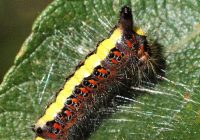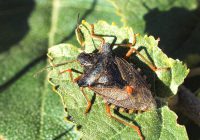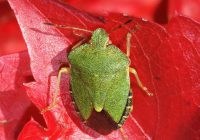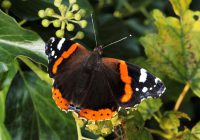Dr Phil Smith’s Wildlife Notes
October 2015
October is usually the wettest month of the year but, this year, small amounts of rain fell on only nine days making it one of the driest in living memory. Following on from the September drought meant there was no recharge of the dune ground water-table, which remained at a record low level. Edge Hill University researcher, Nick O’Keeffe, found the water was 48cm below the surface at Devil’s Hole on 30th. It will therefore take about 15cm (6 inches) of rainfall to produce any flooding in the slack. Wicks “Lake” at Formby Point, where visitors usually enjoy feeding the ducks, has been bone dry for about five months.
One result of the exceptionally mild sunny weather was an insect bonanza. On 1st, I counted 15 Common Darters at Pinfold Pond on Ainsdale Sand Dunes National Nature Reserve, while a spectacularly colourful Grey Dagger moth caterpillar was found nearby. The highlight, however, was a large shieldbug sunning itself on a Silver Birch. With mounting excitement, I identified it as a Red-legged Shieldbug, a species I have never seen before on the Sefton Coast, although it’s supposed to be fairly common and widespread. My list of shieldbugs for the dunes increased to 11, an impressive total, though two or three more may yet await discovery. Other species encountered during the month included several Green Shieldbugs, two of which I found on flame-red Virginia-creeper at Hightown. They were not exactly well camouflaged!
Another surprise was a male Ruddy Darter at Birkdale on 2nd, the latest ever recorded in North Merseyside or Lancashire. It was accompanied by at least seven Migrant Hawkers, including two mating pairs, and three Common Darters, while two Sandwich Terns called from the adjacent shore.
Then, on 3rd, a visit to favoured patches of flowering Ivy in Ravenmeols Woods was rewarded with 17 stunning Red Admirals and a Comma. These graced the area for most of the month, with 11 Red Admirals and a single Comma still there on 20th. These south-facing clumps of Ivy also attracted masses of hoverflies, emphasising the importance of this late nectar source.
The absence of frosts meant that duneland wildflowers were plentiful throughout the month, with the scarce Lesser Centaury still in flower on Birkdale Green Beach as late as 30th. Patricia Lockwood asked me to identify a beautiful large-flowered St John’s-wort she found on the side of Wicks path, Formby Point. After a literature search, I pinned it down to Mount Olympus St John’s-wort (Hypericum olympicum) from northern Greece and northwest Turkey, a garden escape that has rarely been seen “in the wild” and never before in the northwest of England.
Three well-attended guided walks were arranged during the month at Marshside for the Lancashire Botany Group, Liverpool Botanical Society and the Botanical Society of Britain & Ireland. Saltmarsh highlights included four species of Glasswort, three different Sea-lavenders (including a rare hybrid) and the uncommon Taschereau’s Orache and Kattegat Orache, which most participants had not encountered before. Even better, however, was a single specimen of the distinctive Long-stalked Orache found by Wendy Atkinson. This was completely new to me, being very local nationally and recorded only once before in the Vice-county many years ago near Preston.
As usual at this time of year, I organised a series of volunteer “buckthorn bashes” to clear invasive Sea Buckthorn from the dunes and slacks near Sands Lake, Ainsdale. We started this work in 2011 and it has made a big difference in the areas first tackled, hardly any of this highly damaging shrub now surviving. There is still plenty of small regrowth in sites cut more recently but, again, up to a dozen volunteers, some from as far afield as Wirral, soon made inroads. Sefton’s Coast & Countryside Service gave permission and helpfully provided loppers for those who didn’t have their own equipment. There wasn’t much time for bird-spotting but I did notice three pairs of Gadwall and two Shovelers on Sands Lake, reflecting the widespread arrival of winter wildfowl.




